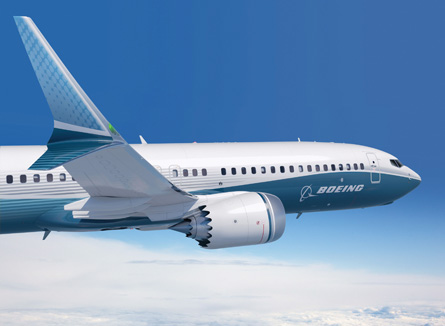Boeing says the "window is closing fast" on making additional configuration changes to the 737 Max after revealing earlier today a strikingly new winglet design and a small new blister fairing under the nose of the fuselage.
The design changes announced so far add up to an 11-13.5% fuel burn improvement for the 737 Max compared to the current generation 737, including a 1-1.5% boost from the new winglets and a negligible impact on performance as a result of the blister fairing.
Beverly Wyse, Boeing's 737 vice-president and general manager, says her team is continuing to look for new improvements for the latest version of the 737, which also features the CFM International Leap-1B engine, and several structural and system updates.
 |
|---|
© Boeing The wing tip is split into upward and downward-pointing surfaces |
However, Boeing also is intending to finalise quickly design requirements that will set the precise payload of the 737 Max, as well as define the range limits of the improved airframe. Boeing says only that the 737 Max will offer comparable payload to the 737NG and be designed with the capacity for increased range.
For the general public, the advanced technology winglets will form the most visible difference between the old and new versions of the 737.
Rather than improving performance by increasing the height of the 737 Max winglets, Boeing has adopted a "dual feather" approach. It splits the wingtips into upward- and downward-pointing surfaces. Such a wingtip device adds less weight than a single upward-pointing surface, says Michael Teal, Boeing's 737 chief engineer.
So far, Boeing has tested the new design in simulations using computational fluid dynamics modelling and in low-speed and transonic wind tunnels, Teal says.
Aviation Partners revealed a similar split wingtip device in October, although there are visible differences. Boeing claims the dual-feather winglet design is exclusively owned by itself.
Earlier this month, Boeing also revealed several aerodynamic changes approved for the 737 Max, including a revised tail cone and a 787-like engine integration with the wing. Boeing also moved to a fly-by-wire system to control the spoilers.
Meanwhile, the larger fan diameter of the Leap-1B engine required Boeing to extend the nose landing gear by 20.3cm (8in). Boeing's latest photos reveal a blister fairing over the nose gear door.
Teal explains the new fairing was necessary because the extended nose gear does not retract completely inside the fuselage. Despite the outer-mould line change, Boeing expects the aerodynamic impact to be negligible, Teal says.
Source: Air Transport Intelligence news























